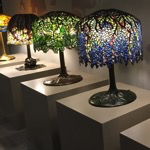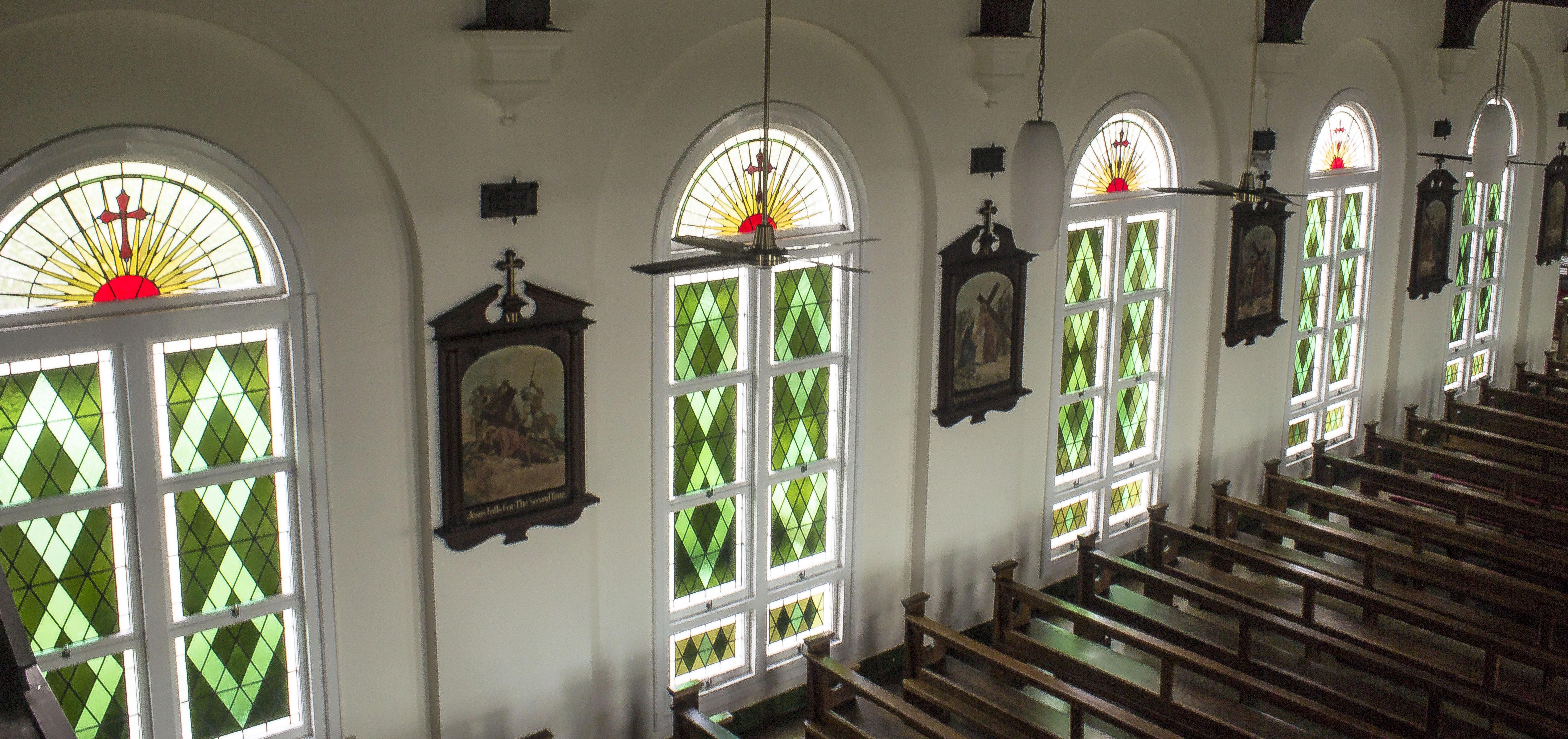 In my 2017 trip to the USA, I made a stop to admire the The Neustadt Collection of Tiffany lamps, at the Queens Museum, in New York. The collection, assembled by Dr. Egon Neustadt (1898-1984) and his wife Hildegard (1911-1961), features a number of delightful copper foil lamps created by Tiffany Studios right in Queens (in Corona to be exact).
In my 2017 trip to the USA, I made a stop to admire the The Neustadt Collection of Tiffany lamps, at the Queens Museum, in New York. The collection, assembled by Dr. Egon Neustadt (1898-1984) and his wife Hildegard (1911-1961), features a number of delightful copper foil lamps created by Tiffany Studios right in Queens (in Corona to be exact).
We have now finished the restoration of the leadlight windows at Our Lady of Victories in Bowen Hills, Queensland. The heritage-listed church was hit by the violent thunderstorm that devastated many Brisbane suburbs in November 2014. The image below show some of the damages done to the church’s window as we photographed in our original survey.

Broken windows at Our Lady of Victories, Bowen Hills (QLD)

Damaged leadlight panel, Our Lady of Victories, Bowen Hills (QLD).

Damaged semicircle leadlight (fanlight), Our Lady of Victories, Bowen Hills (QLD).
The restoration involved repairing more than 80 windows. Of these, most were removed from their original timber casements for reconstruction, while attempting to salvage as much original glass as possible, and match the new glass with the original one. Those with minor damage and no structural concern to the lead were repaired on-site.
The matching was not easy: the windows were originally crafted by the RS Exton Studios, a painters and decorators trade who used to have their warehouse in Brisbane CBD and closed their stained glass business in 1958. The windows of the church date back probably to 1924. The original glass is not produced anymore, and the production processes and colours have since then changed. We managed to recoup some old glass through some stock we had acquired from older stained glass businesses and some demolition yards. However, for a large quantity of glass, we had to commission a custom manufacturing to some glass companies in the US to be able to match the original glass as close as possible. David from Hartley and Williams was of great help in coordinating the sourcing of this glass.

Rebuilding one of the main leadlight panels

On the way to remove leadlights from the tower.
The main damages were concentrated on the south side of the church; however a number of windows throughout the floors of the church’s tower were also damaged; their restoration involved the use of a crane to remove the windows, replace them with temporary perspex (transparent acrylic sheets), and after few weeks replace the restored windows in place.

On-site reparations at Our Ladies of Victories.

When we remove the panels, we place temporary perspex to keep the weather out and the sunlight in.

An example of a poor reparation, carried out in the past, using silicone and cardboard to fill the gap left from a broken glass.
Through the restoration process it became evident that the windows had undergone several reparations in the past, not all carried up to the highest standard. Some glass was replaced with glass that was of completely different tonalities when compared with the original glass, compromising the original history of the windows. Other glass was installed using glues or silicones: this practice is not just an eyesore, but it also puts under serious risks the integrity of the lead that gives the structure to the windows.

Previous repairs have not put much attention in maintaining the original characteristics of the windows: here you can see a clear colour miss-match for one of the diamond shaped glass from a panel in the church’s tower.

Another patchwork of colours due to previous poor quality repairs. It is always difficult to match colours that are not produced anymore, but the differences in colours of the glass used for previous reparations is way too big.

Damaged semicircle from Our Ladies of Victories in Bowen Hills (QLD).

One of the restored large semicircle leadlight (fanlight).
The damaged windows are now all restored to their original appearance. The larger windows are composed from two strips of four top-hinged hoppers, mostly filled with green diamond mullioned glass. The green colour of the windows is to commemorate the armed forces of World War I. Above these panels is placed a semi circular window glazed with a leadlight panel depicting a rising sun, which, continuing with the commemoration of the WWI armed forces, recalls the symbol of the First Australian Imperial Force AIF.

Some of the restored leadlight windows at Our Lady of Victories, Bowen Hills (QLD).

Our Lady of Victories, in Bowen Hills (QLD).

The church’s cross, which was also damaged in the 2014 hail storm, is now back on the top of the tower.
I have recently completed the restoration of 6 leadlight panels from a heritage Queenslander home in Yeronga, Brisbane, built in 1924. The panels have a lovely floral motif and intense purple and aquamarine colours. While the panels were not damaged in the 2014 Brisbane hailstorm that heavily damaged a lot of heritage stained glass windows in the area, they did suffer the harsh Queensland sun and the lead was crumbling down.

One of the leadlight panel before restoration. The lead is crumbling.

Detail of one leadlight panel showing bowing in correspondence of the flower motif.
Interestingly, the same motif was present in other leadlight windows around the house’s veranda: these windows were in immaculate conditions because soon after building, the veranda was enclosed to add more indoor space to the house.

Restored leadlight panels and timber frame casements installed in place at the heritage-listed Yeronga residence.

The restored windows shining through the night.

One of the leadlight panel during the rebuilding phase.
The restoration of these windows was carried out in 6 weeks and all the panels were rebuilt from scratch maintaining the same width and type of lead cames. Few glass pieces were broken but fortunately we were able to match the original glass with some heritage glass we had in stock in Glass Artistry’s studio, thus maintaining the original design: at Glass Artistry, we always strive to matching the glass that needs replacement as close as possible.

The restored leadlight windows installed in the Yeronga house.
Along with the restored panels, we provided to the owners a full report detailing the status of the windows. We also organised for the restoration of the original timber frames of the leadlight windows. Once we removed the leadlight, my collaborator John Britnell from JayBee Woodworks took all silky oak frames apart, brought them back to bare timber, reconstructed the damaged portion by inserting matching silky oak. John then stained the internal part of frames by carefully recreating the original stained and also recoated the external part of the frames.

John from JayBee Woodworks completing the installation of a leadlight panel into its timber frame casement.

John and I applying the last touches to the restored timber frames with the installed leadlights.
The owners of the restored leadlight panels sent me a very kind email of appreciation of the restoration works:
Hi Magda,As you know, both Shirley and I are extremely happy with the service you have provided in the restoration of our windows. You showed the utmost care, from understanding our needs at the beginning of the project, through to the planning and execution of the work.
Your skill and artistry has added a great deal of heritage value to our home, and we would not hesitate to recommend your services.
So, thank you again for your professionalism and for the obvious passion you have for your craft, you really looked after us.
All the best for the future, and our sincerest gratitude for all your efforts.
Warm regards,
Luke Harrison

The restored leadlight panels ready for installation.


